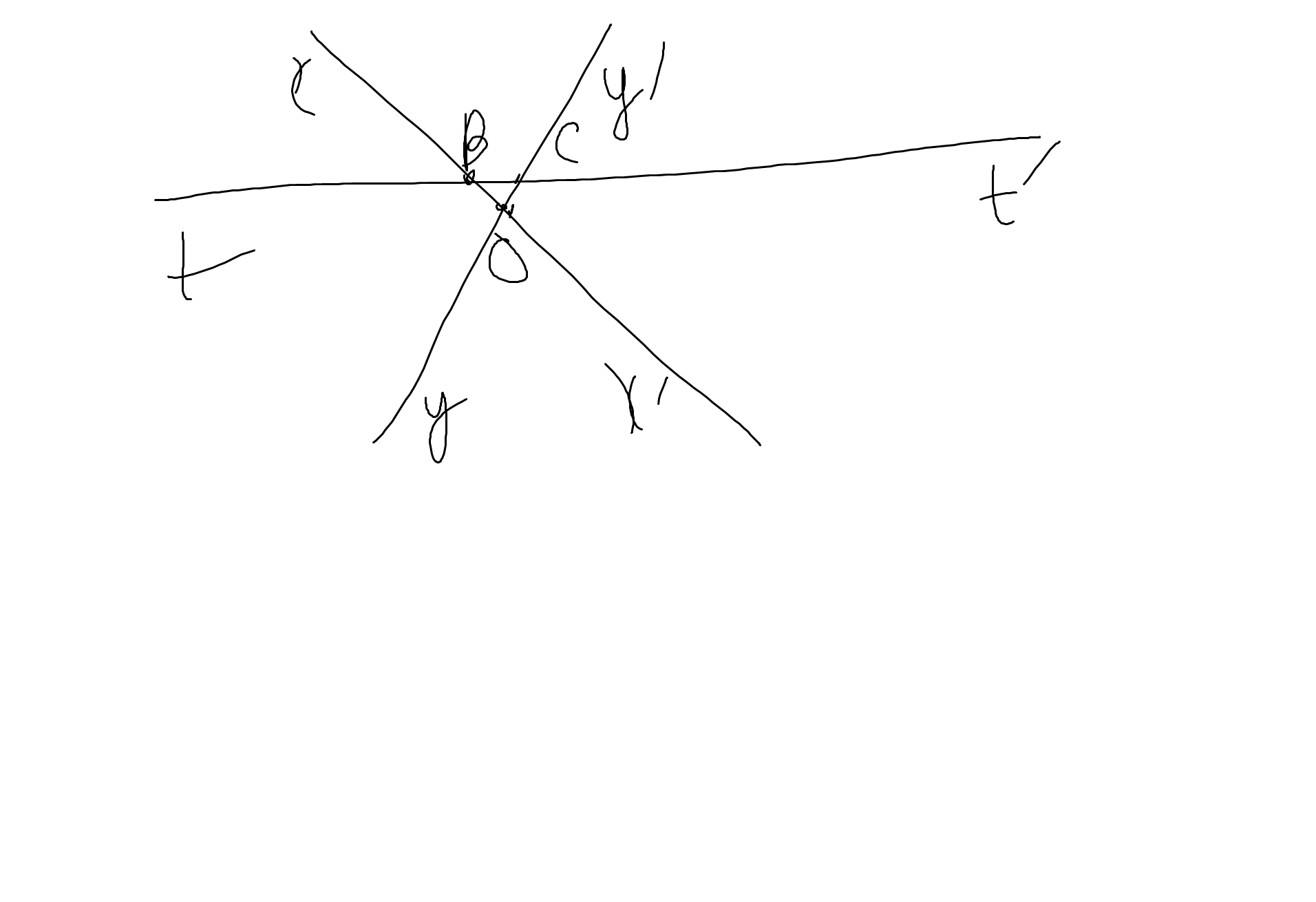cho góc xOy=150 độ.Vẽ tia Oz bất kì nằm trong góc đó.Gọi Oa và Ob theo thứ tự là tia phân giác của góc xOz và zOy.Tính góc aOb
VẼ HÌNH LUÔN NHA
Hãy nhập câu hỏi của bạn vào đây, nếu là tài khoản VIP, bạn sẽ được ưu tiên trả lời.

a: Sau 3 giờ, xe máy đi được: 3x40=120(km)
Hiệu vận tốc hai xe là 60-40=20(km/h)
Hai xe gặp nhau sau khi ô tô đi được: 120:20=6(giờ)
b: Điểm gặp nhau cách A:
6x60=360(km)

Kẻ tia `Ot` là tia đối của tia `Ox`
=> \(\widehat{xOt}=180^o\)
Ta có:
\(\widehat{yOt}=\widehat{xOt}-\widehat{xOy}=180^o-120^o=60^o\)
=> \(\widehat{tOz}=\widehat{zOy}-\widehat{yOt}=134^o-60^o=74^o\)
Mà \(\widehat{xOz};\widehat{zOt}\) là 2 góc kề bù
=> \(\widehat{zOx}+\widehat{zOt}=\widehat{xOt}\)
=> \(\widehat{xOz}=\widehat{xOt}-\widehat{tOz}=180^o-74^o=106^o\)
Vậy ...

Tổng chiều dài và rộng của hình chữ nhật là:
`21,6 : 2 = 10,8 (dm)`
Đổi `80% =` \(\dfrac{4}{5}\)
Ta có sơ đồ:
Chiều dài: (5 phần)
Chiều rộng: (4 phần)
Tổng số phần bằng nhau là:
`5+4 = 9` (phần)
Giá trị 1 phần là:
`10,8 : 9 = 1,2 (dm)`
Chiều dài hình chữ nhật:
`1,2` x `5 = 6 (dm)`
Chiều rộng hình chữ nhật là:
`10,8 - 6 = 4,8 (dm)`
Diện tích hình chữ nhật là:
`6` x `4,8 = 28,8 (dm^2)`
Đáp số: `28,8 dm^2`

Bài 3: Các cặp góc so le trong là: \(\widehat{tBO};\widehat{BOC}\); \(\widehat{OBC};\widehat{yOB}\); \(\widehat{BCO};\widehat{x'OC}\); \(\widehat{t'CO};\widehat{BOC}\)
Các cặp góc đồng vị là:
\(\widehat{xBt};\widehat{xOy}\); \(\widehat{tBO};\widehat{x'Oy}\); \(\widehat{y'Ct'};\widehat{x'Oy'}\); \(\widehat{t'CO};\widehat{x'Oy}\)

Bài 2:
Các cặp góc so le trong là \(\widehat{FEC};\widehat{ACB}\)
Các cặp góc đồng vị là \(\widehat{ADE};\widehat{ABC}\); \(\widehat{AED};\widehat{ACB}\)
Các cặp góc trong cùng phía là: \(\widehat{BDE};\widehat{B}\); \(\widehat{DEC};\widehat{ECB}\)

\(x^3+ax+b\\ =\left(x^3+4x^2+3x\right)+\left(-4x^2-16x-12\right)+\left(a+13\right)x+\left(b+12\right)\\ =x\left(x^2+4x+3\right)-4\left(x^2+4x+3\right)+\left(a+13\right)x+\left(b+12\right)\\ =\left(x-4\right)\left(x^2+4x+3\right)+\left(a+13\right)x+\left(b+12\right)\)
Để `x^3+ax+b` chia hết cho `x^2+4x+3` thì:
\(\left\{{}\begin{matrix}a+13=0\\b+12=0\end{matrix}\right.=>\left\{{}\begin{matrix}a=-13\\b=-12\end{matrix}\right.\)

`x (2x - 9) = 3x(x - 5) `
`<=> 2x^2 - 9x = 3x^2 - 15x`
`<=> 3x^2 - 2x^2 - 15x + 9x =0`
`<=> x^2 - 6x = 0`
`<=> x(x-6) = 0`
`<=> x = 0` hoặc `x - 6 = 0`
`<=> x = 0` hoặc `x = 6`
Vậy ....

\(\left(4x+2\right)\left(x^2+1\right)=0\)(1)
Ta có: `x^2>=0` với mọi x
`=>x^2+1>=1>0` với mọi x
`=>x^2+1≠0`
\(\left(1\right)\Leftrightarrow4x+2=0\\ \Leftrightarrow4x=-2\\ \Leftrightarrow x=-\dfrac{2}{4}=-\dfrac{1}{2}\)
`(4x + 2)(x^2 + 1) = 0`
Trường hợp 1:
`4x + 2 = 0`
`<=> 4x = -2`
`<=> x =` \(-\dfrac{1}{2}\)
Trường hợp 2:
`x^2 + 1 = 0`
`<=> x^2 = -1` (Không tồn tại `x`)
Vậy `x =` \(-\dfrac{1}{2}\)

\(g.x^3-3x^2+3x-1=0\\ \Leftrightarrow\left(x-1\right)^3=0\\ \Leftrightarrow x-1=0\\ \Leftrightarrow x=1\\ h.x\left(2x-7\right)-4x+14=0\\ \Leftrightarrow x\left(2x-7\right)-2\left(2x-7\right)=0\\ \Leftrightarrow\left(2x-7\right)\left(x-2\right)=0\\ \Leftrightarrow\left[{}\begin{matrix}2x=7\\x=2\end{matrix}\right.\\ \Leftrightarrow\left[{}\begin{matrix}x=\dfrac{7}{2}\\x=2\end{matrix}\right.\\ k.\left(2x-5\right)^2\left(x+2\right)^2=0\\ \Leftrightarrow\left[{}\begin{matrix}2x-5=0\\x+2=0\end{matrix}\right.\\ \Leftrightarrow\left[{}\begin{matrix}2x=5\\x=-2\end{matrix}\right.\\ \Leftrightarrow\left[{}\begin{matrix}x=\dfrac{5}{2}\\x=-2\end{matrix}\right.\\ l.x\left(2x-9\right)=3x\left(x-5\right)\\ \Leftrightarrow3x^2-15x-2x^2+9x=0\\ \Leftrightarrow x^2-6x=0\\ \Leftrightarrow x\left(x-6\right)=0\\ \Leftrightarrow\left[{}\begin{matrix}x=0\\x=6\end{matrix}\right.\\ m.\left(x^2-2x+1\right)-4=0\\ \Leftrightarrow\left(x-1\right)^2=2^2\\ \Leftrightarrow\left[{}\begin{matrix}x-1=2\\x-1=-2\end{matrix}\right.\\ \Leftrightarrow\left[{}\begin{matrix}x=2+1=3\\x=-2+1=-1\end{matrix}\right.\)
a: (3x-2)(4x+5)=0
=>\(\left[{}\begin{matrix}3x-2=0\\4x+5=0\end{matrix}\right.\Leftrightarrow\left[{}\begin{matrix}x=\dfrac{2}{3}\\x=-\dfrac{5}{4}\end{matrix}\right.\)
c: \(\left(4x+2\right)\left(x^2+1\right)=0\)
mà \(x^2+1>=1>0\forall x\)
nên 4x+2=0
=>4x=-2
=>\(x=-\dfrac{1}{2}\)
d: (2x+7)(x-5)(5x+1)=0
=>\(\left[{}\begin{matrix}2x+7=0\\x-5=0\\5x+1=0\end{matrix}\right.\Leftrightarrow\left[{}\begin{matrix}x=-\dfrac{7}{2}\\x=5\\x=-\dfrac{1}{5}\end{matrix}\right.\)
f: \(\left(x^2-4\right)\left(x-2\right)\left(3-2x\right)=0\)
=>\(\left(x-2\right)^2\cdot\left(x+2\right)\left(3-2x\right)=0\)
=>\(\left[{}\begin{matrix}x-2=0\\x+2=0\\3-2x=0\end{matrix}\right.\Leftrightarrow\left[{}\begin{matrix}x=2\\x=-2\\x=\dfrac{3}{2}\end{matrix}\right.\)

Từ 2 đến 201 số lượng số hạng là: (201 - 2) : 1 + 1 = 200 (số hạng)
Số lượng cặp là: 200 : 2 = 100 (cặp)
1 - 2 + 3 - 4 + 5 - ... + 199 - 200 + 201
= 1 + (-2 + 3) + (-4 + 5) + ... + (-198 + 199) + (-200 + 201)
= 1 + 1 + 1 + ... + 1 + 1
= 1 + 100*1
= 1 + 100
= 101
Oa là phân giác của góc xOz
=>\(\widehat{zOa}=\dfrac{\widehat{xOz}}{2}\)
Ob là phân giác của góc zOy
=>\(\widehat{zOb}=\dfrac{\widehat{zOy}}{2}\)
\(\widehat{aOb}=\widehat{zOa}+\widehat{zOb}=\dfrac{1}{2}\left(\widehat{xOz}+\widehat{zOy}\right)\)
\(=\dfrac{1}{2}\cdot\widehat{xOy}=\dfrac{1}{2}\cdot150^0=75^0\)